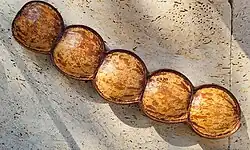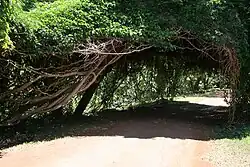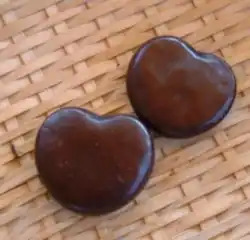Entada gigas
| Entada gigas | |
|---|---|

| |
| Seed pod, Parque Ecológico Jaguaroundi, Veracruz, Mexico | |
| Scientific classification | |
| Kingdom: | Plantae |
| Clade: | Tracheophytes |
| Clade: | Angiosperms |
| Clade: | Eudicots |
| Clade: | Rosids |
| Order: | Fabales |
| Family: | Fabaceae |
| Subfamily: | Caesalpinioideae |
| Clade: | Mimosoid clade |
| Genus: | Entada |
| Species: | E. gigas
|
| Binomial name | |
| Entada gigas | |
| Synonyms[2] | |
| |
Entada gigas, commonly known as the monkey-ladder, sea bean, cœur de la mer or sea heart, is a species of flowering liana in the pea family, Fabaceae, subfamily Mimosoideae. It is native to Central America, the Caribbean, northern South America, and Africa.[2] It is notable for having the largest seedpods in the Fabaceae.[3]
Description
Generative characteristics

The fruit measures 12 cm (4.7 in) across and can reach 2 m (6.6 ft) long, with reports of pods up to 2.5 m (8 ft) long.[4][5] This pod, like all legumes, is a single carpel, the largest carpel of any known plant. Inside each pod are ten to fifteen seeds, each of which have a diameter of 6 cm (2.4 in) and a thickness of 2 cm (0.79 in).[6] The seeds contain a hollow cavity, which gives them buoyancy. After being washed by rain into rivers and then the ocean, the seeds can drift long distances on ocean currents. Seed buoyancy and vitality lasts at least two years.[7]
Use
In Gabon it is used to make ropes and nets.[8]
-
_seeds.jpg) Sea heart (Entada gigas) seeds
Sea heart (Entada gigas) seeds -
 A canopy formed over lianas
A canopy formed over lianas -
 Entada gigas seeds, resembling hearts
Entada gigas seeds, resembling hearts -
_(8182069333).jpg) Botanical illustration from 1827
Botanical illustration from 1827
References
- ^ "Entada gigas". Germplasm Resources Information Network. Agricultural Research Service, United States Department of Agriculture. Retrieved 2009-04-01.
- ^ a b "Entada gigas (L.) Fawc. & Rendle". Plants of the World Online. 2006-12-01. Retrieved 2025-08-01.
- ^ Arbel, Ilil (2004). Amazing Plants. Courier Dover Publications. p. 27. ISBN 978-0-486-43336-3.
- ^ Bailey, Liberty Hyde, ed. (1935). Cyclopedia of Horticulture. New York: MacMillan and Co. p. Vol. 1 p. 1116.
- ^ Dodge, Charles R. (1897). "A Descriptive Catalogue of Useful Fiber Plants of the World". U.S.D.A. Fiber Investigation Report. 9 (1): 157.
- ^ Kaplan, Eugene H. (1988). A Field Guide to Southeastern and Caribbean Seashores: Cape Hatteras to the Gulf Coast, Florida, and the Caribbean. Houghton Mifflin Harcourt. p. 148. ISBN 978-0-395-97516-9.
- ^ Loewer, H. Peter (2005). Seeds: the Definitive Guide to Growing, History, and Lore. Timber Press. p. 66. ISBN 978-0-88192-682-8.
- ^ Fibres. p.153. (2012). Niederlande: Prota Foundation.
External links